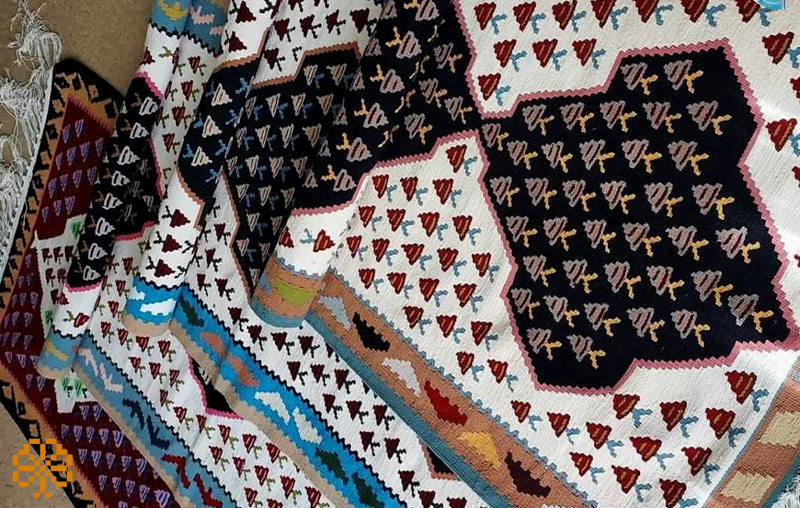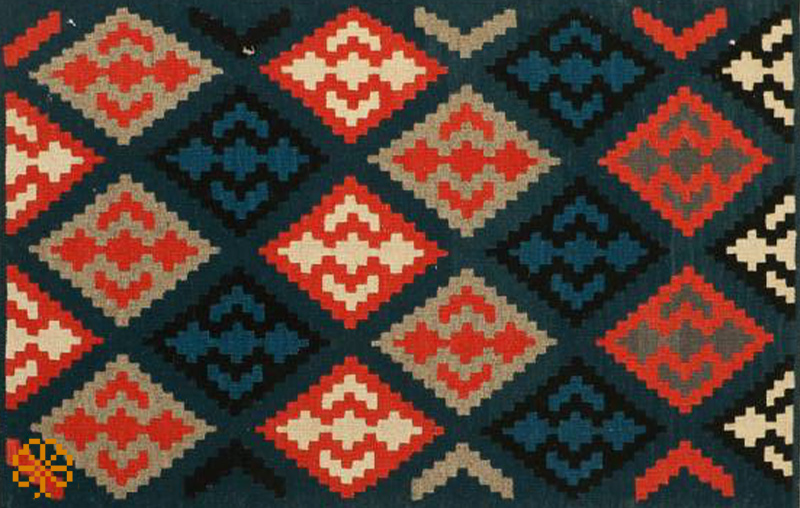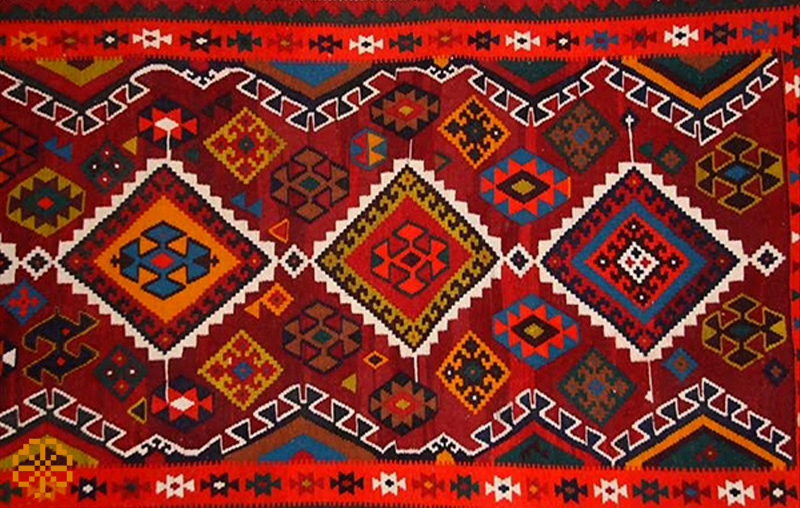Types of handmade kilims and their exact knowledge

Knowing the types of handmade kilims and knowing them can guide you a lot when buying. A kilim is a relatively simple weave that is used as a rug in many areas. The material of kilims generally consists of two animal raw materials; Goat hair and fleece.
In this article from Farahan Carpet, we intend to examine the types of handmade kilims in detail so that you can choose the best option when buying by comparing different models.
All kinds of handmade kilims
The art of kilim weaving can be considered as one of the most original Iranian arts, and by looking at it, you can clearly see a manifestation of art and elegance while being simple.
In general, kilim is a kind of handmade that, unlike carpets, has no fluff and its texture is more common among nomadic and rural people.
Rugs are rooted in the history of the area in which they are woven, so their designs and colors vary greatly depending on the subject.
To identify the types of handmade kilims, you should pay attention to the issue on what basis and what characteristics you intend to categorize them? In this article we have tried based on three characteristics; Categorize their dimensions, type of texture and texture area for you and examine different models for you.
Types of kilims in terms of texture type
Based on the method and tools used for their weaving, different types of handmade kilims can be divided into 3 main categories:
1. Plain or flat kilim
This type of kilim, which is also known as double-sided and simple, is woven in a simple style, as their name suggests, so that the two sides of the kilim are exactly the same, and both sides of the kilim can be used. .
This type of kilim is less thick than other models and is the most common option among all types of handmade kilims. Qashqai, Saneh and Bijar lemons in Kurdistan, Musnad and simple carpets of Ardabil, Semnan and Zanjan are in this group.
2. One-sided kilim or varnish
This type of kilim, also known as somak, is less thick than the previous option, has a woven fabric texture, and has a Caucasian origin, and has been woven for a long time in Iran and Turkey.
The first weavers of this type of kilims were nomads and as you should have guessed, it should be more popular in the Turkish-speaking regions of Iran. Varni is in fact one of the types of kilims in Ardabil and East Azarbaijan provinces, which has geometric patterns, animals and simple motifs.
3. Embossed or fluffy kilim
Among the types of handmade kilims, this type is the most similar to handmade carpets and it is done in such a way that it is tied to the rug from the map and at the end, the piles or the extra creams are removed.
Of course, it is necessary to mention that in this type of kilims, the background is designed in a simple way and various designs and drawings are not used much like carpets.
Types of kilims in terms of dimensions and size
Kilims are generally smaller in size than the size of handmade carpets and are larger than rugs. If we want to determine the types of handmade kilims based on size, we must say:
1. A small rug that is woven with an average size of 65 x 95 cm.
2. The kilim has an average size of 110 x 165 cm.
٣. Middle kilim, the size of which is about 150 x 250 cm.
4. The average kilim is 280 cm long and 70 cm wide on average.
5. Long kilim that is more than 400 x 200 cm.
Types of handmade kilims in terms of area and region
This type of division can be said to be the main and best option, because as we said, depending on the area in which the kilim is woven, each kilim has its own specifications and features, and you need to know how to buy a good kilim. Get acquainted with each of them.
1. Qashqai kilim (the most famous kilim in Iran)
Among the types of handmade kilims, Qashqai kilim can definitely be introduced as one of the most famous options, and the reason for this fame can also be introduced in the variety of designs and colors.
In fact, these kilims are woven either when the tribe dies or when they migrate, and the scenery around the weaver has a high variety and beauty, which makes the woven design have a special result.
Unique geometric designs, wool delicacy, brightness of colors, the use of animal designs such as goats and peacocks are the most important and characteristics of Qashqai kilims.
Read more: Kashan handmade carpet | Check purchase specifications and features
2. Shahsoni kilim (the most delicate kilim)
From the point of view of fame, perhaps the only option that can compete with the Qashqai kilim is the Shahsoni kilim. The texture of kilims in the Shahsoon tribe, which is one of the largest tribes in Iran, is so high that the kilims woven by them alone are divided into a separate category.
If you remember, in the first part, we introduced a group of kilims called Verni; This is exactly the kilim woven in this Shahsoon; Very delicate kilims that mostly have animal designs such as deer, horses and birds and are woven with coarse and dry wool.
Another feature that is evident in Shah Soon kilims is the use of large and embossed patterns that are used in a row in the design.
3. Glim Hersin
Among the types of handmade kilims that we have studied so far, it can be said that Hersin kilim has the most flexibility and its weavers weave many designs and designs depending on their taste and imagination.
Hersin, which is one of the regions of Kermanshah province, is one of the main centers of Iranian kilim weaving. The colors used in the kilims of this region are mostly gray, green, white, red, purple and more recently magenta.
Another prominent feature of Hersin kilim is that it is full of borders and backgrounds with a wide variety of designs, so much so that you can rarely find empty space in it.
4. Baluch kilim
It is interesting to know that the people of this region, due to the environmental and climatic conditions, have always tried to show the desire for water resources and pastures in their projects. That is why Baluch kilims can be full of striped designs.
In general, handicrafts with brown, liver, dark red, camel and dark blue colors can be seen in these areas, which are combined with happy colors such as green, yellow and red.
5. Khamseh or Fars kilim
In Fars province, Qashqai kilim has the largest volume of weaving and production, but other kilims are also woven in this region, the most famous of which is Khamseh kilim, which is derived from the names of five Shirazi tribes that have been mixed together.
It is interesting to know that among these five nations; There are two ethnic groups of Arabic, two ethnic groups of Turks and one ethnic group of Persians. In this province, among the types of carpets, only horizontal and metal samples are used, and the type of kilim that is woven is somaki or the same as varnish.
In Khamseh kilim, the use of beautiful colors is the first letter; Also, the background of the design that is woven is more dark and on it, stars are woven diagonally in the shape of interwoven rhombuses.
Other types of handmade kilims
Because the number of woven kilims in Iran has a variety and different types, in the following, we will introduce them to you only briefly:
Larry kilim: Among the types of handmade kilims, this kilim can be introduced as one of the highest quality options, which is mostly used for storing equipment and pouch weaving.
Zarand kilim: This kilim is also woven in a slit by the Turkic tribes of Shahsoon, which is basically a long, narrow and at the same time strong size.
Saneh kilim: This kilim is special for Sanandaj city and has a special elegance and the use of plant designs, lines and diagonals is very common in it.
Kurdistan kilim: The colors include bold red, light pink, dirty pink and bold green, and twisted woolen yarn is used for its texture.
Turkmen kilims: These kilims are strong and light, and the designs are categorized based on an original pattern called a flower.
In this article, we have tried to examine the types of handmade kilims in detail, but if you have any questions or ambiguities about what has been said, you can share it with us in the comments section.











